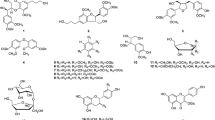Abstract
To assess the anti-inflammatory activity of the constituents of the roots of Aralia continentalis, ent-pimara-8(14),15-diene-19-oic acid (continentalic acid, pimaradienoic acid, compound I), 7β-hydroxy-ent-pimara-8(14),15-diene-19-oic acid (compound II), 7-oxo-ent-pimara-8(14),15-diene-19-oic acid (compound III), 15α,16α-epoxy-17-hydroxy-ent-kauran-19-oic acid (compound IV) and ent-kaura-16-en-19-oic acid (kaurenoic acid, compound V), their inhibitory effects against cyclooxygenase-2 (COX-2)-catalyzed PGE2 and inducible nitric oxide synthase (iNOS)-catalyzed NO production by lipopolysaccharide-treated RAW 264.7 cells were examined. Among the compounds tested, compound III and V moderately inhibited NO production. In addition, compound III weakly inhibited PGE2 production, while treatment with compounds II and IV at concentrations of up to 100 µM had no significant effects. Conversely, compound I only weakly inhibited PGE2 and NO production. To elucidate the mechanism by which these changes occurred, the iNOS down-regulating capacity of compound III was investigated. Western blot analysis and an electrophoretic mobility shift assay demonstrated that compound III weakly inhibited COX-2 and iNOS expression at 50–100 µM, and inhibited NF-κB activation. When in vivo anti-inflammatory activities of compounds I, III and V were examined, intraperitoneal injection of 4–100 mg/kg of compound I and V significantly inhibited carrageenaninduced paw edema in mice, whereas compound III did not. Taken together, the results of this study suggest that some constituents of A. continentalis, especially compounds I, III and V, exert significant anti-inflammatory activity, which suggests that these constituents contribute, at least in part, to the anti-inflammatory action of the roots of A. continentalis.
Similar content being viewed by others
References
Bae, Y. H., Huh, J. E., Lee, J. D., Choi, D. Y., and Park, D. S., Effect of Aralia cordata extracts on cartilage protection and apoptosis inhibition. Biol. Pharm. Bull., 29, 1423–1430 (2006).
Chi, Y. S., Cheon, B. S., and Kim, H. P., Effect of wogonin, a plant flavone from Scutellaria radix, on the suppression of cyclooxygenase and the induction of inducible nitric oxide synthase in lipolpolysaccharide-treated RAW 264.7 cells. Biochem. Pharmacol., 61, 1195–1203 (2001).
Dang, N. H., Zhang, X., Zheng, M., Son, K. H., Chang, H. W., Kim, H. P., Bae, K., and Kang, S. S., Inhibitory constituents against cyclooxygenases from Aralia cordata Thunb. Arch. Pharm. Res., 28, 28–33 (2005).
Gallin, J. I. and Snyderman, R., Overview, In Gallin, J. L., and Snyderman, R. (Eds.), Inflammation: Basic principles and clinical correlates 3rd ed. Lippincott Williams & Wilkins, Philadelphia, pp. 1–4 (1999).
Herz, W., Kulanthaivel, P., and Watanabe, K., ent-Kauranes and other constituents of three Helianthus species. Phytochem., 22, 2021–2025 (1983).
Kang, O-H., Chae, H-S., Choi, J-G., Oh, Y-C., Lee, Y-S., Kim, J. H., Seung, M-J., Jang, H-J., Bae K-H., Lee, J-H., Shin, D-W., and Kwon, D. Y., ent-Pimara-8(14),15-dien-19-oic acid isolated from the roots of Aralia cordata inhibits induction of inflammatory mediators by blocking NF-κB activation and mitogen-activated protein kinase pathways. Eur. J. Pharmacol., 601, 179–185 (2008).
Lee, G. I., Ha, J. Y., Min, K. R., Nakagawa, H., Tsurufuji, S., Chang, I. M., and Kim, Y., Inhibitory effects of oriental herbal medicines on IL-8 induction in lipopolysaccharide-activated rat macrophages. Planta Med., 61, 26–30 (1995).
Mihashi, S., Yanagisawa, I., Tanaka, O., and Shibata, S. Diterpenes of Aralia species. Tetrahedron Lett., 21, 1683–1686 (1969).
Mossman, T., Rapid colorimetric assay for cellular growth and survival: application to proliferation and cytotoxic assays. J. Immunol. Methods, 65, 55–63 (1983).
Okuyama, E., Nishimura, S., and Yamazaki, M., Analgesic principles from Aralia cordata Thunb. Chem. Pharm. Bull., 39, 405–407 (1991).
Paiva, L. A., Gurgel, L. A., Silva, R. M., Tome, A. R., Gramosa, N. V., Silveira, E. R., Santos, F. A., and Rao, V. S., Anti-inflammatory effect of kaurenoic acid, a diterpene from Copaifera langsdorffi on acetic acid-induced colitis in rats. Vascul. Pharmacol., 39, 303–307 (2002).
Park, H. J., Hong, M. S., Lee, J. S., Leem, K. H., Kim, C. J., Kim, J. W., and Lim, S., Effects of Aralia continentalis on hyperalgesia with peripheral inflammation. Phytother. Res., 19, 511–513 (2005).
Perry, L. M., Medicinal plants of East and Southeast Asia: Attributed properties and uses. MIT press, Cambridge, pp 41 (1990).
Shibata, S., Mihashi, S., and Tanaka, O., The occurrence of (−)-pimarane-type diterpene in Aralia cordata Thunb. Tetrahedron Lett., 51, 5241–5243 (1967).
Tirapelli, C. R., Ambrosio, S. R., Coutinho, S. T., de Oliveira, D. C., da Costa, F. B., and de Oliveira, A. M., Pharmacological comparison of the vasorelaxant action displayed by kaurenoic acid and pimaradienoic acid. J. Pharm. Pharmacol., 57, 997–1004 (2005).
Winter, C. A., Risley, E. A., and Nuss, G. W., Carrageenaninduced edema in the hindpaw on the rat as an assay for anti-inflammatory drugs. Proc. Soc. Exp. Biol. Med., 111, 544–547 (1962).
Yahara, S., Ishida, M., Yamasaki, K., Tanaka, O., and Mihashi, S., Minor diterpenes of Aralia cordata Thunb: 17-hydroxyent-kaur-15-en-19-oic acid and grandifloric acid. Chem. Pharm. Bull., 22, 1629–1631 (1974).
Author information
Authors and Affiliations
Corresponding author
Rights and permissions
About this article
Cite this article
Lim, H., Jung, H.A., Choi, J.S. et al. Anti-inflammatory activity of the constituents of the roots of Aralia continentalis . Arch. Pharm. Res. 32, 1237–1243 (2009). https://doi.org/10.1007/s12272-009-1909-3
Received:
Revised:
Accepted:
Published:
Issue Date:
DOI: https://doi.org/10.1007/s12272-009-1909-3




